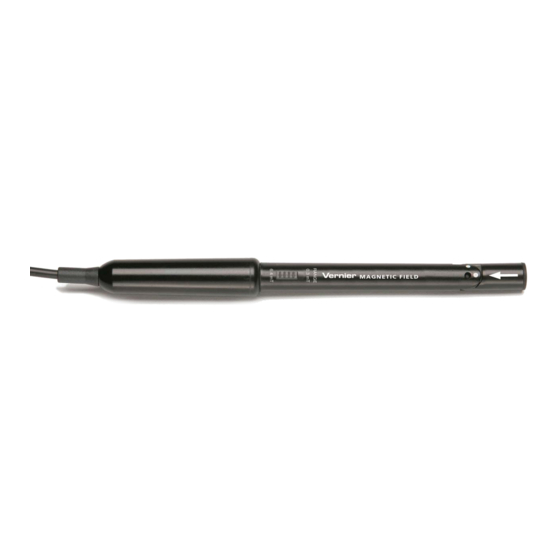
Table of Contents
Advertisement
Quick Links
Magnetic Field Sensor
(Order Code MG-BTA)
The Vernier Magnetic Field Sensor measures a vector
component of the magnetic field near the sensor tip.
The tip can be adjusted, allowing the user to
measure fields that are parallel or perpendicular to the long axis of the sensor. The
Magnetic Field Sensor can be used for a variety of interesting experiments
involving magnetic fields.
Measure and study the Earth's magnetic field.
Determine the direction of magnetic north.
Study the magnetic field near a permanent magnet.
Measure the field near a current-carrying wire.
Measure the field at the opening of a solenoid.
Note: Vernier products are designed for educational use. Our products are not
designed nor are they recommended for any industrial, medical, or commercial
process such as life support, patient diagnosis, control of a manufacturing
process, or industrial testing of any kind.
Compatible Software and Interfaces
See
www.vernier.com/manuals/mg-bta
with the Magnetic Field Sensor.
Getting Started
1. Connect the sensor to the interface (LabQuest Mini, LabQuest 2, etc.).
2. Start the appropriate data-collection software (Logger Pro, Logger Lite,
LabQuest App) if not already running, and choose New from File menu.
The software will identify the sensor and load a default data-collection setup. You
are now ready to collect data.
If you are collecting data using a Chromebook™, mobile device such as iPad
Android™ tablet, or a Vernier wireless sensor or interface, please see the following
link for up-to-date connection information:
www.vernier.com/start/mg-bta
Using the Sensor
Connect the sensor following the steps in the Getting Started section of this user
manual.
Use the switch on the sensor shaft to select an appropriate range.
The 6.4 mT range is used to measure relatively strong magnetic fields around
permanent magnets and electromagnets.
The 0.32 mT range is used mainly to measure the magnetic field of the Earth
and very weak fields. It can be used for other magnets, but the sensor must
remain in one position so that the reading is not affected by the background
field of the Earth.
for a list of interfaces and software compatible
Videos
View videos related to this product at
Calibration
You should not have to perform a new calibration when using the
Magnetic Field Sensor. We have set the sensor to match our stored calibration
before shipping it.
It is not practical to calibrate the Magnetic Field Sensor without reference to a
known source of magnetic field. It is useful, however, to zero the
Magnetic Field Sensor. Position the sensor and zero it using your data-collection
software. Move the magnetic field source, and not the sensor, to explore the spatial
variations of the field.
Moving the sensor will upset the zero since the background magnetic field in your
lab probably varies with position. For experiments measuring the spatial variation
of a magnetic field, it is better to zero the sensor and then move the source to
various positions.
Specifications
13-bit resolution
12-bit resolution
10-bit resolution
Stored calibration value
(±0.32 mT range in millitesla)
Stored calibration value
(±6.4 mT range in millitesla)
®
or
Stored calibration value
(±0.32 mT range in gauss)
Stored calibration value
(±6.4 mT range in gauss)
How the Sensor Works
The sensor uses a Hall-effect transducer. It produces a voltage that is linear with
magnetic field. The sensor measures the component of the magnetic field that is
perpendicular to the white dot on the end of the sensor tip. The reading is positive
when the white dot on the sensor points toward a magnetic south pole.
www.vernier.com/mg-bta
±0.32 mT range: 0.0001 mT
±6.4 mT range: 0.002 mT
±0.32 mT range: 0.0002 mT
±6.4 mT range: 0.004 mT
±0.32 mT range: 0.0008 mT
±6.4 mT range: 0.016 mT
slop: 0.160 mT/V
intercept: –0.320 mT
slope: 3.225 mT/V
intercept: –8.063 mT
slope: 1.6 gauss/V
intercept: –3.2 gauss
slope: 32.25 gauss/V
intercept: –80.625 gauss
2
Advertisement
Table of Contents

Summary of Contents for Vernier MG-BTA
-
Page 1: Specifications
If you are collecting data using a Chromebook™, mobile device such as iPad ® Stored calibration value slope: 1.6 gauss/V Android™ tablet, or a Vernier wireless sensor or interface, please see the following (±0.32 mT range in gauss) link for up-to-date connection information: intercept: –3.2 gauss www.vernier.com/start/mg-bta... -
Page 2: Troubleshooting
If you have watched the related product video(s), followed the troubleshooting Logger Pro, Logger Lite, Vernier LabQuest 2, LabQuest Mini, and other marks shown are our trademarks or steps, and are still having trouble with your Magnetic Field Sensor, contact registered trademarks in the United States.














Need help?
Do you have a question about the MG-BTA and is the answer not in the manual?
Questions and answers